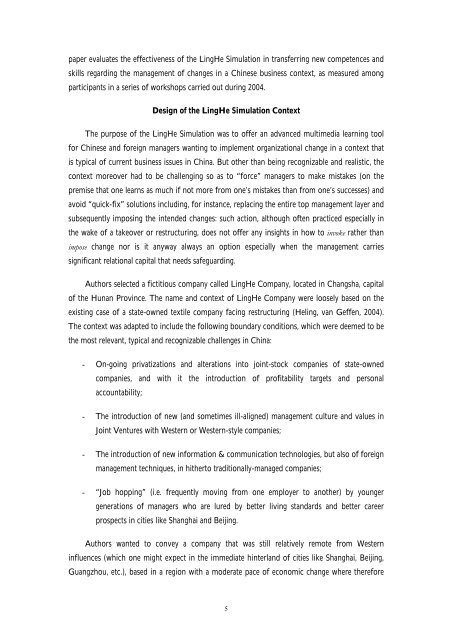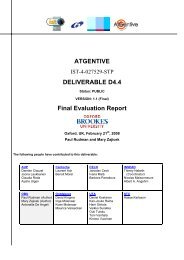LingHe Simulation - INSEAD CALT
LingHe Simulation - INSEAD CALT
LingHe Simulation - INSEAD CALT
Create successful ePaper yourself
Turn your PDF publications into a flip-book with our unique Google optimized e-Paper software.
paper evaluates the effectiveness of the <strong>LingHe</strong> <strong>Simulation</strong> in transferring new competences and<br />
skills regarding the management of changes in a Chinese business context, as measured among<br />
participants in a series of workshops carried out during 2004.<br />
Design of the <strong>LingHe</strong> <strong>Simulation</strong> Context<br />
The purpose of the <strong>LingHe</strong> <strong>Simulation</strong> was to offer an advanced multimedia learning tool<br />
for Chinese and foreign managers wanting to implement organizational change in a context that<br />
is typical of current business issues in China. But other than being recognizable and realistic, the<br />
context moreover had to be challenging so as to “force” managers to make mistakes (on the<br />
premise that one learns as much if not more from one’s mistakes than from one’s successes) and<br />
avoid “quick-fix” solutions including, for instance, replacing the entire top management layer and<br />
subsequently imposing the intended changes: such action, although often practiced especially in<br />
the wake of a takeover or restructuring, does not offer any insights in how to invoke rather than<br />
impose change nor is it anyway always an option especially when the management carries<br />
significant relational capital that needs safeguarding.<br />
Authors selected a fictitious company called <strong>LingHe</strong> Company, located in Changsha, capital<br />
of the Hunan Province. The name and context of <strong>LingHe</strong> Company were loosely based on the<br />
existing case of a state-owned textile company facing restructuring (Heling, van Geffen, 2004).<br />
The context was adapted to include the following boundary conditions, which were deemed to be<br />
the most relevant, typical and recognizable challenges in China:<br />
- On-going privatizations and alterations into joint-stock companies of state-owned<br />
companies, and with it the introduction of profitability targets and personal<br />
accountability;<br />
- The introduction of new (and sometimes ill-aligned) management culture and values in<br />
Joint Ventures with Western or Western-style companies;<br />
- The introduction of new information & communication technologies, but also of foreign<br />
management techniques, in hitherto traditionally-managed companies;<br />
- “Job hopping” (i.e. frequently moving from one employer to another) by younger<br />
generations of managers who are lured by better living standards and better career<br />
prospects in cities like Shanghai and Beijing.<br />
Authors wanted to convey a company that was still relatively remote from Western<br />
influences (which one might expect in the immediate hinterland of cities like Shanghai, Beijing,<br />
Guangzhou, etc.), based in a region with a moderate pace of economic change where therefore<br />
5
















